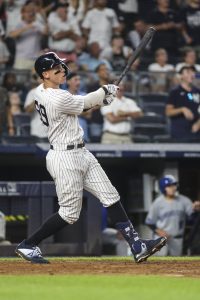The Giants are widely expected to be one of the league’s most active teams this offseason, with the front office reloading after an underwhelming 2022 season. President of baseball operations Farhan Zaidi met with reporters (including John Shea of the San Francisco Chronicle) this evening and confirmed the team could play near the top of the market.
Asked about the club’s free agent priorities, Zaidi told the media “from a financial standpoint, there would be nobody that would be out of our capability.” He went on to note they’ve already had discussions with representatives for free agent shortstops who’ve expressed a willingness to move to second base in deference to Brandon Crawford (via Jon Morosi of MLB.com). Teams technically aren’t allowed to negotiate contract terms with free agents from other teams until tomorrow evening, but they can discuss more general concepts like roster fit during the exclusive negotiation period.
Zaidi didn’t specify the players involved, although it’s not hard to infer he’s speaking about the top shortstops on the market. Carlos Correa, Trea Turner, Xander Bogaerts and Dansby Swanson are going to be priority targets for a number of the game’s biggest-spending teams. It’s notable that Zaidi spoke of potentially moving an external pickup to the other side of the bag while keeping Crawford at shortstop, although it’s not clear if that’s an absolute requirement for any player under consideration. Scott Boras, who represents both Correa and Bogaerts, told reporters he hasn’t heard from teams looking to push either player off the position (link via Bob Nightengale of USA Today).
While adding a top shortstop is plausible for a San Francisco club looking to get younger and more athletic this winter, Zaidi and his group are sure to cast a wide net. The mention of the financial wherewithal to pursue any player available will lead to further speculation about the market’s top free agent. The Giants are sure to be linked to Aaron Judge throughout the winter, as they’re indeed among the clubs most well-positioned for that kind of expenditure. San Francisco has roughly $72.5MM in guaranteed commitments on the books, pending a call on Evan Longoria’s option. Even with a fairly heavy arbitration class, the Giants have plenty of room before approaching this year’s $155MM Opening Day mark, and they’re nowhere near the franchise-record heights that pushed $200MM.
Of course, San Francisco is facing a few potential key departures. Ace Carlos Rodón opted out of the second year of his deal and is back on the open market. Zaidi confirmed the club’s obvious decision to tag him with a $19.65MM qualifying offer (via Alex Pavlovic of NBC Sports Bay Area), which Rodón is a lock to reject in pursuit of a deal north of nine figures. That’d entitle the Giants to a compensatory draft choice between Competitive Balance Round B and the third round (roughly 75th overall) in next year’s draft if the star southpaw departs.
San Francisco also sees corner outfielder Joc Pederson hit the open market, and while he certainly won’t receive a QO, Zaidi reiterated the team would like to keep him around (Shea link). The lefty-hitting outfielder posted a .274/.353/.521 line after signing a $6MM guarantee last offseason, and the club has discussed a potential extension as far back as September. Pederson is sure to beat $6MM this time around and looks to have a good shot at a multi-year contract after his quality platform year.

